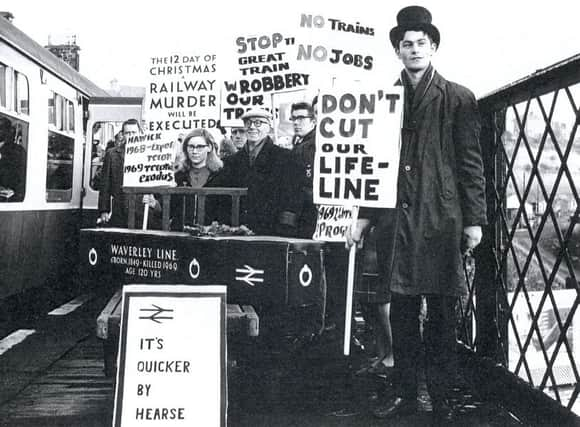Coffins, detonators and bomb threats: Closure of the Borders Railway recalled


The Waverley route between Edinburgh and Carlisle went out with very much a bang rather than a whimper 50 years ago last weekend.
Those who took part in the dramatic events relived them at an event at Stow on Saturday to commemorate the anniversary.
Advertisement
Hide AdAdvertisement
Hide AdIt provided a vivid illustration of the strength of feeling in the Borders at the loss of its railway.
Former Liberal Party leader Lord Steel, among those who unsuccessfully campaigned for its retention, told the meeting, which he chaired: “I felt really shocked the railway was closed. No one thought it would happen.”
Other speakers included Kim Elliot, who, as a schoolboy, accompanied his mother Madge to present an 11,600-signature petition to 10 Downing Street, and Andrew Boyd, then a law student, donned undertaker’s garb complete with top hat to load a mock coffin onto one of the last trains from Hawick.
Even more dramatically, Mr Boyd recalled that a caller from Galashiels had claimed there was a bomb on the train.
Lord Steel also said a locomotive had to be sent ahead of the last service - an Edinburgh-London sleeper - to clear the line of warning detonators placed on the track.
The former Borders MP, who was aboard the sleeper, related his key role in calming furious protestors who had blocked its path by occupying a level crossing at Newcastleton - pictured on the front page of The Scotsman of 7 January 1969.
Lord Steel described the blockade as a “very serious demonstration of anger” at the closure decision.
He recalled being summoned from his berth to speak to the protestors, addressing them from a footbridge in the early hours of what he said was a bitterly cold night.
Advertisement
Hide AdAdvertisement
Hide AdThey only agreed to disperse after Lord Steel negotiated the release of the local minister, a protest leader who was being held by the police.
Of course, the injustice felt in the Borders at the closure was partially righted in 2015 with the re-opening of around a third of the line, between Edinburgh and Tweedbank.
But the campaign to extend it south is very much continuing, spurred on by growing passenger numbers, especially at the three Borders stations, where the number of travellers has far exceeded forecasts.
The Campaign for Borders Rail’s approach seems an eminently sensible one. It realises, like many experts, that rebuilding the line all the way to Carlisle, through sparsely populated country, is a long shot, despite attracting support from politicians.
However, as secretary Nick Bethune explained to the meeting, simply focusing on an extension to Hawick would risk it becoming lost among the many other Scottish re-opening campaigns.
I’m told by those in the know that there are fewer physical obstacles in returning the line to Hawick than there were to Tweedbank.
However, Mr Bethune said it was crucial to maintain a “cross-Border vision”, which would also improve Hawick’s links with the south.
Who knows, if proposed upgrades to the east and west coast main lines as part of extending HS2 to Edinburgh and Glasgow founder, and they become increasingly congested, there could be a case for restoring that historic third Anglo-Scottish rail link.